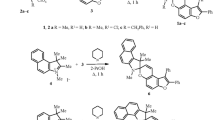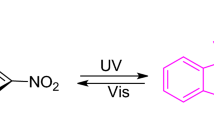Abstract
Dipole-dipole coupling of the indane fragments in 5,5′-disubstituted 2,2′-spirobiindanes is predominantly responsible for the origin of optical activity in the1La-electronic transition only if both ligands exhibit strong interaction with the aromatic nuclei. This mechanism does not contribute essentially to the1Lb-Cotton effect.
The band-splittings of the couplet as well as the rotational strengths of the transitions ofA andB symmetry-type in the1La-Cotton effect are in accordance with a rough calculatory estimation.
The absolute configuration thus determined agrees with the chirality recently deduced by chemical methods.
The rotational strengths of the1W-Cotton effect of the carbonyl derivatives4, 5, 12, 13, and15 located at appr. 320 nm are remarkably low. This can be explained on the basis of conformational considerations.
Similar content being viewed by others
Literatur
H. Keller undH. Lehner, Mh. Chem.106, 1117 (1975).
F. Ciardelli undP. Salvadori, Hrsg., Fundamental Aspects and Recent Developments in Optical Rotatory Dispersion and Circular Dichroism. London: Heyden. 1973.
E. Langer, H. Lehner undK. Schlögl, Tetrahedron29, 2473 (1973).
G. Haas, P. B. Hulbert, W. Klyne, V. Prelog undG. Snatzke, Helv. Chim. Acta54, 491 (1971).
H. Keller, Ch. Krieger, E. Langer, H. Lehner undG. Derflinger. Tetrahedron34, 871 (1978).
R. K. Hill undD. A. Cullison, J. Amer. Chem. Soc.95, 1229 (1973).
H. Falk, W. Fröstl, O. Hofer undK. Schlögl, Mh. Chem.105, 598 (1974).
O. E. Weigang, jr. undM. J. Nugent, J. Amer. Chem. Soc.91, 4555 (1969);M. J. Nugent undO. E. Weigang, jr., ibid. J. Amer. Chem. Soc.91, 4556 (1969).
S. Hagishita, K. Kuriyama, M. Hayashi, Y. Nakano, K. Shingu undM. Nakagawa, Bull. Chem. Soc. Japan44, 496 (1971);S. Hagishita, K. Kuriyama, K. Shingu undM. Nakagawa, ibid. Bull. Chem. Soc. Japan44, 2177 (1971).
S. Hagishita undK. Kuriyama, Tetrahedron28, 1435 (1972).
J. H. Brewster undR. T. Prudence, J. Amer. Chem. Soc.95, 1217 (1973).
R. C. Cookson undS. McKenzie, Proc. Roy. Chem. Soc.1961, 423.
H. Eyring, H.-Ch. Liu undD. Caldwell, Chem. Rev.68, 525 (1968).
J. A. Schellman, Acc. Chem. Res.1, 144 (1968).
S. F. Mason, in: Some Newer Physical Methods in Structural Chemistry (R. Bonnett undJ. G. Davis, Hrsg.), London: United Trade Press, 1967.
S. F. Mason, J. Chem. Soc., Chem. Commun.1973, 239.
A. Meyer, H. Neudeck undK. Schlögl, Chem. Ber.110, 1403 (1977).
A. L. Goodman undR. H. Eastman, J. Amer. Chem. Soc.86, 908 (1964).
E. Langer undH. Lehner, Tetrahedron29, 375 (1973).
J. R. Platt, J. Chem. Phys.17, 484 (1949); idemJ. R. Platt ibid. J. Chem. Phys.19, 263 (1951);J. Petruska. ibid. J. Chem. Phys.34. 1120 (1961).
E. Langer undH. Lehner, Publikation in Vorbereitung.
Ch. Krieger, H. Lehner undK. Schlögl, Mh. Chem.107. 195 (1976).
P. Crabbé, in: An Introduction to the Chiroptical Methods in Chemistry. Mexico: Syntex. 1971.
Author information
Authors and Affiliations
Additional information
6. Mitt.:H. Neudeck undK. Schlögl, Chem. Ber.110. 2624 (1977).
Rights and permissions
About this article
Cite this article
Langer, E., Lehner, H., Neudeck, H. et al. Optisch aktive aromatische Spirane, 7. Mitt. Circulardichroismus optisch aktiver 5,5′-disubstituierter 2,2′-Spirobiindane. Monatshefte für Chemie 109, 987–999 (1978). https://doi.org/10.1007/BF00907320
Received:
Published:
Issue Date:
DOI: https://doi.org/10.1007/BF00907320




